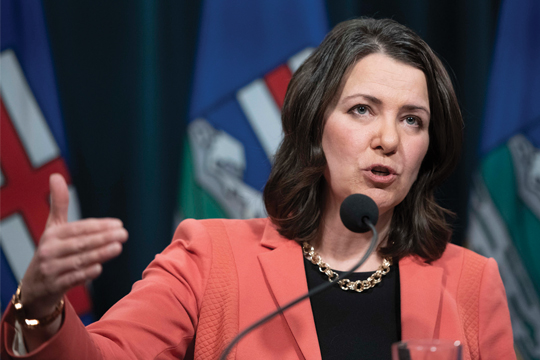
Alberta Premier Danielle Smith has released a report arguing in favour of removing Alberta from the Canada Pension Plan and starting its own Alberta Pension Plan. Photo: Chris Schwartz
In September, the Alberta government presented the report it commissioned on potentially leaving the Canada Pension Plan (CPP) to create a new Alberta Pension Plan (APP). The CPP is one of the largest pension plans in the world, with assets that are sustainable for generations. It’s the cornerstone of Canadians’ retirement, with 21 million participants accessing a portable, secure source of retirement income.
Proponents of Alberta’s plan have made several claims in the last few months. Here, we’ll fact check a few of them.
1. “Alberta’s share of the CPPIB assets is $334 billion.” The CPP Investment Board’s (CPPIB) current assets total $575 billion. The report claims Alberta is owed 53 per cent of them. How could a single province, that represents 16 per cent of total contributions, be owed more than half of the plan’s assets? Simply put, it isn’t.
The report came to that sum by formulating an “alternative interpretation” of the withdrawal provisions in the federal legislation. If this interpretation were used to pay out each province, the plan would run out of money before Alberta and Ontario were paid.
2. “Alberta workers contribute more into the CPP than is spent on Alberta retirees.” Canadians have equal contributions and benefits that are portable throughout the country. Alberta currently has fewer retirees, and its workers have higher wages than elsewhere in Canada, but today’s young workers will retire and benefit from the higher CPP payments their higher incomes earned. In addition, much of the gap between the number of workers and retirees in Alberta is explained by migration — many workers earn funds in Alberta, then retire in their home provinces.
3. “If Quebec can do it, why not Alberta?” Quebec didn’t leave the CPP; it never joined. When the CPP was established in 1966, the provinces could choose to create their own plan or opt in to the CPP. Quebec created the Quebec Pension Plan (QPP). Alberta would be the first province to leave the CPP.
4. “An APP would be cheaper and just as secure.” The report suggests Albertans would pay lower contribution rates under an APP, but the report’s contribution rates are based on Alberta getting 53 per cent of the CPPIB’s assets. If Alberta received a more realistic amount, the province could face higher contribution rates.
That’s because a provincial plan has higher investment and demographic risks than a nationally pooled one. When Quebec opted for its own plan, it had a younger population, so the CPP and QPP had the same contribution rate. However, the province’s population aged more quickly and now the QPP’s minimum contribution rate has been 0.9 per cent higher than the CPP’s since 2011.
Alberta’s population fluctuations and demographics are tied to the oil and gas industry and migration of workers from across Canada. If that industry slows, the province may have to increase contribution rates.
5. “Leaving the CPP will be an easy process.” Not true — even the report says it would be an “extremely large and complex endeavour.”
Alberta would be entirely within its rights to leave the CPP. Under the CPP Act, it needs to give three years notice and provide a plan that offers comparable benefits. But who decides what a “comparable benefit” is and how much the province would be entitled to falls to the federal government.
The CPPIB is not a big bank account with money sitting in it. It is a huge portfolio of diverse assets, many of which are invested for the long-term, including in infrastructure such as highways and utilities. It would take several years and potentially billions of dollars in legal fees and financial losses for the CPPIB to pay out a province that left the CPP — and it would thus put all Canadians’ retirement security at risk.

